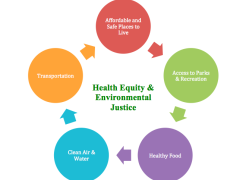Overview
The Colorado Department of Public Health and Environment, along with partners, developed a Health Equity and Environmental Justice 101 training that all department staff are required to take. This training has opened the door for new collaborations across the department, increased awareness of health equity and environmental justice issues, and cultivated new discussions about how to embed equity in public health practice.
Who Took This On
Colorado Department of Public Health and the Environment, Office of Health Equity
Ways You Can Get Started
- Organize a training on health equity, environmental justice, and/or social determinants of health
- Identify others across the health department interested in health equity and form a learning team to advance joint goals
See Advice for Local Health Departments below for more ways to take action.
What Sparked This?
Governor’s initiative highlights the need for centralized health equity activities
In 2011, the governor of Colorado created the LEAN Program Office to help increase the efficiency, effectiveness, and elegance of state government services. During the LEAN assessment of the Colorado Department of Public Health and the Environment (CDPHE), staff discovered that there were multiple isolated groups working on health equity and/or environmental justice across the health department. LEAN program staff recommended the creation of one centralized health equity and environmental justice workgroup to facilitate communication and collaboration between the different divisions of CDPHE.
Health Equity and Environmental Justice Collaborative formed, passes training policy
In 2012, the Health Equity and Environmental Justice Collaborative (HEEJC) was formed to facilitate thoughtful and meaningful conversation about how to advance health equity and environmental justice–related activities across the state health department and within each of the specific CDPHE divisions. HEEJC has representation from every division of CDPHE and is comprised of a main steering committee and subcommittees (e.g., policy, leadership engagement) to facilitate engagement of a variety of staff.
In 2015, the policy and workforce development subcommittees proposed requiring a Health Equity and Environmental Justice 101 training for all 1400+ CDPHE staff to raise awareness and shift the culture toward equity and justice. The subcommittees drafted a proposed health equity and environmental justice policy that called for mandatory staff training, brought it to the department leadership, and ultimately got the training policy passed.
Leadership shift prompted new approaches to the work
Around the same time that HEEJC was advocating for the training policy, the Office of Health Equity (OHE) underwent a major vision transformation. Although the Office had been in existence since 2007, a new director took over in 2015 and implemented a new vision for the Office. As noted by an OHE staff member, “Although the mission statement of ensuring that every Coloradan has an equal opportunity to achieve their full health potential has not changed, the steps to get there have.”
Program Description
Between January and June 2016, staff developed a Health Equity and Environmental Justice 101 training that aimed to “increase awareness and knowledge of the basic principles of health equity and environmental justice.” All CDPHE staff were required to participate in the 101 training within 1 year. Moving forward, the 101 training will be required of all CDPHE staff within the first year of employment.
The training is organized as an in-person 90- to 120-minute facilitated training for approximately 20 staff at a time. There is also an online 45-minute course for those who are unable to attend the in-person sessions.
Where can I find the Health Equity and Environmental Justice 101 training?
The online training is available on the Co.Train website, under course number 1064632. (You must create a free account to access the training.)
By the end of the training, staff are supposed to have a better understanding of how the concepts of health equity and environmental justice relate and can be applied to their work.” The hope is that staff walk away with definitions of the concepts and begin to acknowledge that government employees play a role in making decisions that can lead to inequitable outcomes. Course objectives include:
- Define the terms equity and equality
- Identify determinants of health and social determinants of health
- Consider Dr. Camara Jones’s “three levels of racism” and her proposed solutions
- Summarize the meaning of environmental justice
Colorado staff used materials from various websites including Unnatural Causes, ACPHD’s PH101 Dialogue Series, NACCHO’s Roots of Health Inequity, and CA Newsreel to develop the training, and tried to adapt the content for Colorado’s context. Staff also gave a context for why CDPHE was organizing the training, and were conscious of not creating a training that would overwhelm participants or shut down discussions.
In piloting the training, OHE staff received feedback that participants felt saddened by the concepts and wondered if government and public health were doing anything correctly. In response, they incorporated interviews with 2 health department staff — one working on health equity and the other working on environmental justice within their current capacities — to illustrate that there are many opportunities to take action on health equity and that the Department has already made some progress.
In addition to facilitating the in-person 101 sessions, OHE staff are also responsible for reminding division directors and program supervisors that all existing staff should have already completed the training, and all new staff should do so within one year of their start date.
Outcomes and Impacts
-
Positive feedback on the training
72% of the 225 participants who took the online training gave it a rating of 4 or 5 stars. Evaluation data for the in-person trainings are still being analyzed, but numerous participants noted that the information presented was very useful, informative, and well organized. 12% of online participants rated the training with 1 or 2 stars, a number of whom commented that the training was trying to advance a particular political agenda or socialist propaganda.
-
Participants asking to embed equity in their day-to-day work
A number of participants noted in their training evaluations and in subsequent conversations with OHE staff that they appreciated the training content, but wondered what specifically they could do to embed equity in their day-to-day work and decision making. OHE staff note that this was exactly what they were hoping would happen — that people come out of the 101 training with more questions than they did going in, and that these questions are opportunities to begin furthering equity conversations and work.
-
Training opens doors and builds relationships
OHE staff have found that the training has increased awareness among CDPHE staff about the existence of OHE and that it’s a potential resource for them. For example, one OHE staff member noted that she has started receiving emails from staff in specific divisions asking OHE to help facilitate a conversation with their team about health equity.
-
Training helps to shift the department’s culture toward equity
As described in the other CDPHE case study, this training, along with other recent OHE activities, is helping to shift CDPHE’s culture related to health equity. For example, CDPHE staff reported familiarity with the concepts of structural racism, health equity, and the social determinants of health, but previously had felt that they should not discuss these topics in the department. Following the training and CDPHE’s development of the boilerplate language on structural inequity, staff have reported feeling more empowered to talk about structural racism, and to begin mentioning the social determinants of health in their daily work and meetings.
-
Local health departments are using the training
Local health departments in Colorado have begun to use the health equity and environmental justice training in their jurisdictions — either among health department staff and/or with other government agencies and communities.
Future Steps
OHE staff are working to wrap up their first round of 101 trainings and ensure that all 1400+ CDPHE staff receive the training. Following this, the OHE plans to look at what a 201 training would look like. For example, OHE staff will work with CDPHE divisions individually to help coach them on how to better embed health equity in their day-to-day work.
As described in the other CDPHE case study, OHE is also starting to explore how to change the narrative around data and amplify the types of data collected for population health, performance evaluation, and quality improvement analyses.
OHE staff are also exploring how to coordinate and complement the work of HEEJC. As a relatively new team with a new vision, OHE is still learning to work with the rest of the department in a way that advances health equity and environmental justice and identifies opportunities to address issues, but that is also respectful of time and resource constraints and ongoing responsibilities in each division.
Advice for Local Health Departments
-
Develop a training to help normalize the conversation about equity:
OHE found that the training opened doors to important conversations across CDPHE, as well as facilitated relationship building between OHE and other divisions and offices. Having a training makes it clear that equity is something that CDPHE talks about. Before, people were uncomfortable and unsure if they could talk about equity at work. Now, some people feel more empowered to start using the terms equity, structural racism, and structural inequities.
-
In-person training is better than online, but both are needed:
As expected, the in-person facilitated trainings were found to be more meaningful and lead to much richer and deeper engagement of participants than online trainings. However, the online version of the training was necessary for some people who were unable to attend in-person sessions.
-
There are many resources already available to help you:
Today there are a lot of resources to borrow from to quickly develop a training on health equity. OHE’s 101 training incorporated existing materials and content from organizations across the country. Staff were able to spend time crafting a framework and pulling all the pieces together, rather than having to create content from scratch. The lack of internal resources was a challenge, but they were able to craft something that was meaningful and engaging specifically for the Colorado context, and appears to be impactful.
-
Start small and a snowball effect can occur:
Even if the training is not universally mandated, start by approaching some leadership to ask if you can organize a training for their staff. Doing the training will get people talking, which can potentially have a snowball effect and encourage more people to go through the training.
-
Be prepared for negative pushback:
Although the majority of participants gave very positive feedback, some participants did not understand why they were being required to take the training and/or felt that it was pushing a particular political agenda. In response, during in-person sessions, OHE staff emphasized:
- There is data showing that the social determinants of health play a significant role in creating health inequities — even more than access to medical care.
- Public health is about the public. In the spirit of quality improvement, if there are populations that aren’t healthy, then there are likely things staff could improve in their work.
- Health department leadership signed off on the training for everyone because they feel it is critically important to the work of the department.








